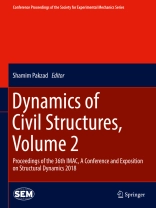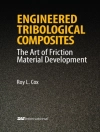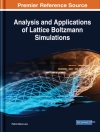Dynamics of Civil Structures, Volume 2: Proceedings of the 36th IMAC, A Conference and Exposition on Structural Dynamics, 2018, the second volume of nine from the Conference brings together contributions to this important area of research and engineering. The collection presents early findings and case studies on fundamental and applied aspects of the Dynamics of Civil Structures, including papers on:
Modal Parameter Identification
Dynamic Testing of Civil Structures
Control of Human Induced Vibrations of Civil Structures
Model Updating
Damage Identification in Civil Infrastructure
Bridge Dynamics
Experimental Techniques for Civil Structures
Hybrid Simulation of Civil Structures
Vibration Control of Civil Structures
System Identification of Civil Structures
表中的内容
Chap 1. Output-Only Structural Identification of a Portal Frame with Frequency Domain Decomposition (FDD) Method.- Chap 2. Experimental Modal Analysis Study of a Standing Soldier and Rifle System.- Chap 3. Performance Characterization of Modal Identification Algorithms, the case of Automated Modal Analysis of Palazzo Lombardia.- Chap 4. Dynamic Characterization of the Little Belt Suspension Bridge by Operational Modal Analysis.- Chap 5. The Prediction of Vibrations for Light Structures in Presence of Moving People.- Chap 6. On Stationarity and the Interpretation of the ADF Statistic.- Chap 7. Simulation of People’s Movements on Floors using Social Force Model.- Chap 8. Using Correlation Functions as Free Decays.- Chap 9. Footbridge Vibrations Predicted by Stochastic Load Model.- Chap 10. Non-structural Masses and Their Influence on Floor Natural Frequencies.- Chap 11. Probabilistic Analysis of Modal Properties for Floor Systems with Uncertain Support Conditions.- Chap 12. Usage of MEMSCapacitive Acceleration Sensors for Structural Monitoring.- Chap 13. Using the Random Decrement Technique on Short Records with Varying Signal-to-noise Ratios.- Chap 14. Why a Curb Shouldn’t be Kicked to the Curb: The Importance of Non-Structural Elements in Dynamic Modelling.- Chap 15. Dynamic Behavior of a 130 Years Old Building Under Excessive Sound Pressure.- Chap 16. Scenario Based Approach for Load Identification.- Chap 17. The Realisation of An Inerter-Based System using Fluid Inerter.- Chap 18. Experiences from the Five-year Monitoring of a Long-span Pontoon Bridge -What Went Right, What Went Wrong and What’s Next?.- Chap 19. Development of a 3-DOF Structural Displacement Sensor Based on a Two-Stage Kalman Filter.- Chap 20. Effects of Pedestrian Excitation on Two Short-Span FRP Footbridges in Delft.- Chap 21. Vibrational Response of Structures Exposed to Human-induced Loads.- Chap 22. Protection of Critical Assets from the Effects of Ground Vibrations.- Chap 23. Experimental Characterisation of the Dynamics Performance of an All-FRP Truss Bridge.- Chap 24. Modal Parameter Uncertainty Estimates as a Tool for Automated Operational Modal Analysis: Applications to a Smart Building.- Chap 25. Modeling Human-structure Interaction using Control Models: External Excitation.- Chap 26. Measurement of Human Loads Using Computer Vision.- Chap 27. Automatic Detection of Structural Deficiencies using 4D Hue-Assisted Analysis of Color Point Clouds.- Chap 28. Human Activity Benchmark Classification using Multilayer Artificial Neural Network.- Chap 29. Cracking Influence on Dynamic Parameters of Reinforced Concrete Floors.- Chap 30. Paradigm Shift in Structural Vibration Serviceability: New Assessment Framework Based on Human’s Experience of Vibration.- Chap 31. State-of-the-Art and Future Directions for Predictive Modelling of Offshore Structure Dynamics using Machine Learning.- Chap 32. Structural Identification of a Five-Story Reinforced Concrete Office Building in Nepal.-Chap 33. Structural Identification for Dynamic Strain Estimation in Wind Turbine Towers.- Chap 34. Modal Parameter Identification from Measurements of Vehicle-bridge Interaction.- Chap 35. Bridge Structural Identification using Moving Vehicle Acceleration Measurements.- Chap 36. NDE of Additively Manufactured Parts via Directly Bonded and Mechanically Attached Electromechanical Impedance Sensors.- Chap 37. Classification of Human Walking Patterns through Singular Value Decomposition Projection.- Chap 38. Dynamic Characterization of a Prestressed Concrete Bridge by Strain and Acceleration Measurements.- Chap 39. Evaluation of a New Energy-Based Human Tracking Method in a Smart Building Using Floor Vibration Measurements.- Chap 40. Innovative Sensing by Using Deep Learning Framework.- Chap 41. The Role of Control-Structure Interaction in Deployable Autonomous Control Systems.- Chap 42. Support Vector Machine-based Face Direction Detection using an Infrared Array Sensor.- Chap 43. Estimation of Remaining Useful Life of a Fatigue Damaged Wind Turbine Blade with Particle Filters.- Chap 44. A Numerical Investigation of a Gravity-Compensated Nonlinear Energy Sink for the Passive Control of Flooring Systems.- Chap 45. Characterizing Structural Changes to Estimate Walking Gait Balance.- Chap 46. Load Rating of a Reinforced Concrete T-beam Bridge Through Ambient Vibration Testing and Finite Element Model Updating.- Chap 47. Identifying Modal Characteristics of Reinforced Concrete Bridges Using Smartphones.- Chap 48. Model Updating and Damage Assessment of a RC Structure using a Finite Element Model.- Chap 49. Modal Properties of a Model of a Chinese Pagoda.- Chap 50. Advanced Fourier-based Model of Bouncing Loads.- Chap 51. Defining Groupings and Classification of Human Gait using Correlation of Ground Reaction Force Measurements.
关于作者
Dr. Shamim N. Pakzad is Director of CEE Graduate Programs and Associate Professor
of Civil and Environmental Engineering, ATLSS Engineering Research Center
Imbt Labs, Lehigh University, Bethlehem, PA, USA.












